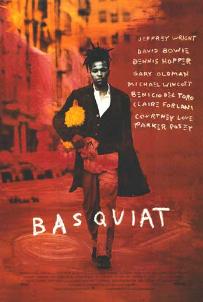Critical reception
The film received positive reviews from critics. On review aggregator website Rotten Tomatoes, the film has a 67% rating based on 30 reviews, with an average rating of 6.9/10. The website's critics consensus reads, "With affected strokes, Basquiat paints an expressionist portrait of a misfit artist, masterfully rendered by a riveting Jeffrey Wright." [12] Metacritic reports a 65 out of 100 rating based on 20 critics, indicating "generally favorable" reviews. [13]
Roger Ebert of the Chicago Sun-Times awarded the film three and a half out of a possible four stars stating that in Schnabel's portrayal of Basquiat "is a quiet, almost wordless presence, a young man who rarely says what he is thinking and often deliberately chooses to miss the point of a conversation. He is dreamy, sweet, and pensive. There are deep hurts and angers". [14] Janet Maslin in The New York Times called the film "bold, attention-getting and more than a little facile, a stylish-looking film without the connective tissue to give it real depth." [15]
David Bonetti of the San Francisco Chronicle gave the film a poor review due to his perception of the inexperience of the director, stating, "Schnabel can't decide whether he wants to tell a traditional rise-and-fall morality tale or make an art film. His attempt at telling Basquiat's story straightforwardly collapses under its own banality". [16] Similarly, the Los Angeles Examiner said that "Basquiat does not seem interested in anything that doesn't advance its director's personal agenda." The review stated that "Though as a writer-director, Schnabel's work is not the total fiasco the debut films of fellow artists David Salle ( Search and Destroy ) and Robert Longo ( Johnny Mnemonic ) were, it is fascinating to see what a compendium of Troubled Genius movie cliches he has turned out." Like several of the negative reviews, the review picked out for praise the acting of Jeffrey Wright as Jean-Michel Basquiat, saying "Basquiat's only genuine inspiration was casting Jeffrey Wright, who won a Tony for his work in Angels in America on the New York stage, as the artist. An actor whose talent is visible even in this standard role, Wright's ability creates more interest in Basquiat's fate than would otherwise exist." [17]
The reviews in the art press focused more on the relation of Schnabel as director to his portrayal of Schnabel as artist in the film, and on changes to the facts of Basquiat's life introduced by Schnabel to make a more accessible film. In Art in America, the art critic Brooks Adams wrote:
Basquiat can be seen as a huge, lurking self-portrait of the artist-Schnabel, not Basquiat. So laden is the film with the innumerable coincidences of Basquiat and Schnabel's enthusiasms (among others, for pajamas and surfing) that the movie should be more appropriately called My Basquiat... To a remarkable degree, the movie succeeds, by dint of its authorial slant, in popularizing the myth of Basquiat as a young, gorgeous, doomed, yet ultimately transcendent black male artist, even as it extends and reinflates the myth of Schnabel as a protean, Picassoid white male painter... Yet for all one's apprehension about the very idea of Schnabel making such a film, Basquiat turns out to be a surprisingly good movie...It is also an art work. [18]
